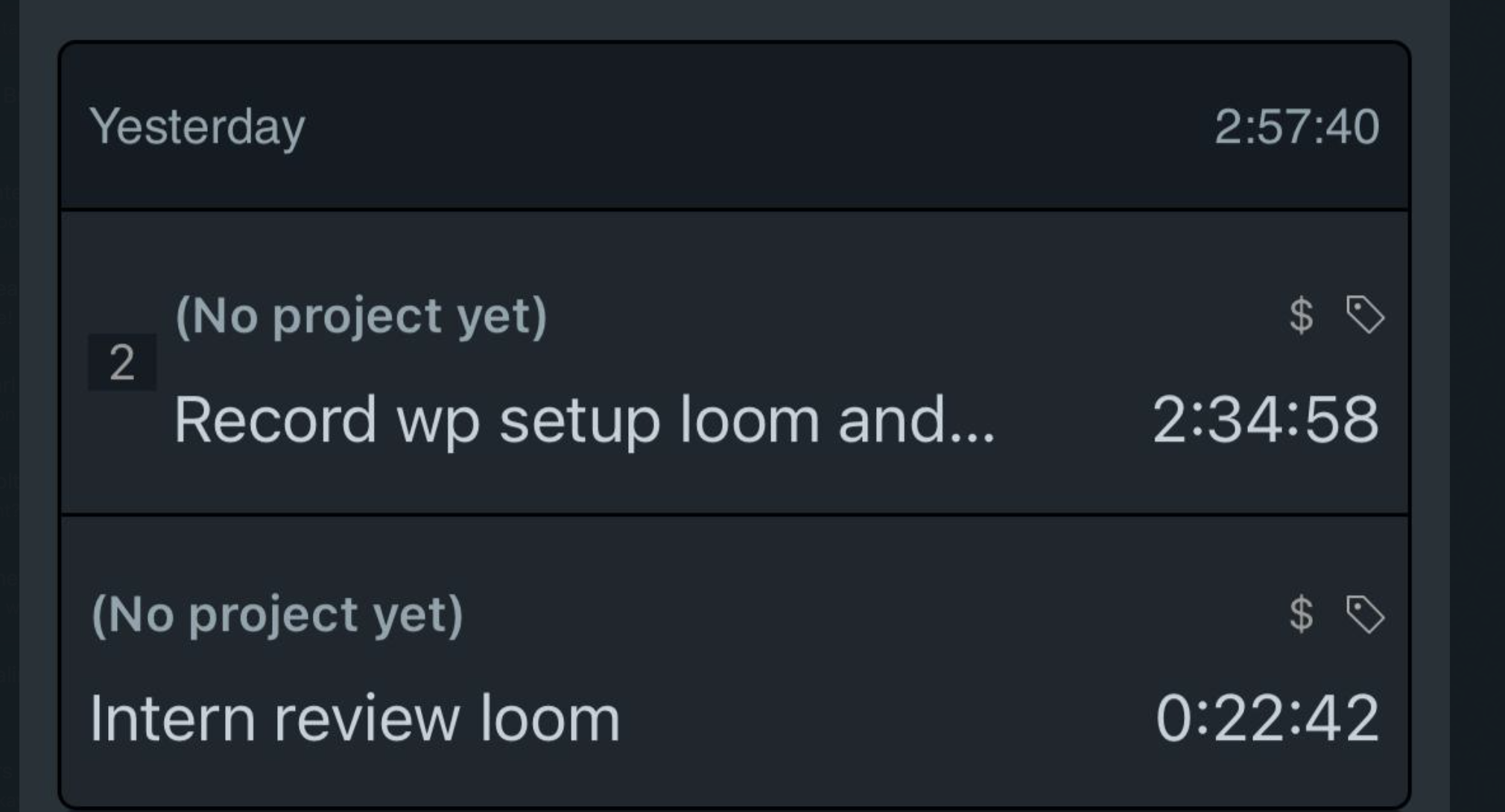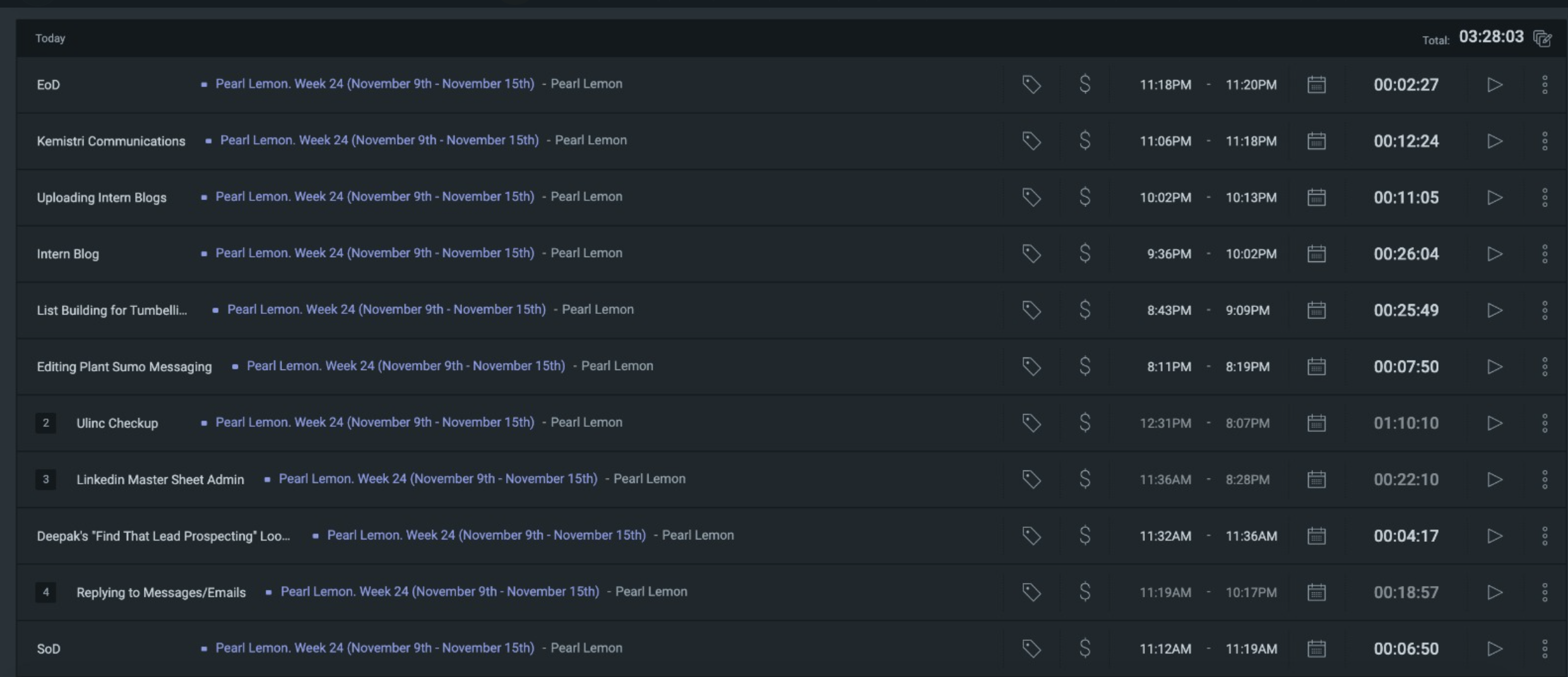Hello all,

Here’s the time right now, and in 30 minutes I’ve got to head out and get over to my running coaching session in Ealing Common.
Right now I’m ‘fire-fighting’ as the lead volume at Pearl Lemon has dropped by 80% over the last 3-5 days and I’m trying to figure out where the drop came from.
Weirdly, I’m actually quite excited by this happening…
Every time there’s a significant problem with Pearl Lemon it sends me into a frenzy which results in us seeing a decent amount of growth
Already I’ve:
- Asked Tenny (in India), to walk through our site and figure out what issues there are
- Allocated Salahuddin (in Bangladesh) to add CTA’s in all of our blog posts
- Asked Kaushal (in India) to fix some of the problems I’ve found on our contact us and book a call pages
- Asked Sam (in the USA) to look at our retargeting ads
- And of course there’s me (in the UK) working through some of our Google Analytics
Fundamentally – only good things will come from this investigation – given I’ve already discovered several errors we would benefit from resolving
With people in India, USA, Mainland Europe (and we’re trying to bring an Aussie and a Filpino into the team), and with there being no set working hours….
You can pretty much always have someone to communicate with, no matter the time of the day
It’s really nice, and even though we’re a small organisation – it’s a distinct competitive advantage that means we’re more nimble than most businesses we compete against or even service.
In amongst all of this Pearl (a Swiss-based content writer whose recently joined the team) – sent this across to me:
She suggested I put together some content about how Pearl Lemon is totally remote – does 75k MRR and I’m still working in the mornings out of Mcdonald’s because I really like their £1 tea (thanks mum!).
Thanks, Pearl (yes that’s her real name – pretty cool right?!).
With that in mind – let’s begin:
Today I woke up late at 6.45 am (need to get back to hitting my 430am’s)
And this is what I saw:


This means that 3 members of the team have already started working – Tenny, Lokesh, Pearl (and Inderpreet also).
3 in India, 1 in Switzerland.
Pearl Lemon has always been remote, and I believe it to be imperative to the success of my team, their happiness and our success.
And what I’d love to do now is to run through is the system that I employ to run a team totally remote that’s highly effective:
Table of Contents
The Effective Management Of Remote Teams

Mindset

It’s worth beginning with an attitude to this all. None of it will work if you don’t trust in the remote model and don’t trust that people can work remotely and still be highly motivated to succeed
I’d invite you to look at how you operate best – when you’re being watched? Or when you have the freedom to do great work.
I know you know the answer.
How To Hire An Effective Remote Team

I think one of the worries people have – is how can you trust people to do their work remotely?
At some level – you have to trust that your team may well be doing several things at once besides the work they do for your business – and ultimately you will never know exactly what’s happening.
However, trust is the key part here – as long as remote hires do the work they say they will do for you AND THEN SOME – there’s not alot more you can ask for.
So with this in mind let’s get into it:
The Technology Advantage With Remote Teams

Now looking at people who are looking for a remote opportunity (at the moment with Covid 19)…is easy.
Almost everyone is looking for a remote opportunity.
Those who are familiar with it offer an innate competitive advantage compared to someone who wants an office environment.
Those who wish to work remotely tend to be technologically a little savvier than those who don’t.
This also means their ability to pick up new ‘digital learnings’ from tools, hacks, and all tend to be quicker.
I know because I’ve tried to hire people inhouse (back when I had an office)…and the way they’d fumble around Google Docs, send Word attachments and Wetransfer files instead of unlisted YouTube videos…was a challenge.
This is a massive generalisation of course – and it’s not to say (as is established) that the remote model doesn’t come without it’s challenges.
But from a technology perspective – remote teams need to be on top of things to function effectively.
Hiring A Remote Employee

Hiring works no different to some degree than you would search for someone in a typical fashion.
You put job ads out and see what comes back. In the instance of Pearl Lemon we hire directly and have never used a recruiter, and it’s been a real journey to establish a stringent process to weed out really good people
For reference our best platforms for hiring people are: Angel.co and Work In Startups I think – this is where the vast majority of our people have come from. But every month or so we’re trying a new job platform here or there to see if it’ll prove fruitful.
Using that strategy (effectively copy-pasting your advert to a new platform) you tend to uncover new places to find great people every few months.
For many people – this is the job of a recruiter – but a recruiter will never know my business as well as I do – and with this in mind, we’ve bolted together an incredibly (in our opinion) effective way to hire remote people.
[convertful id=”197358″]
Our Application Process

We hire people in exactly the manner in which we tend to work, and this is the key distinction that ensures we get people who are a good cultural fit.
We’ve currently got around 35 people across the team including employees, freelancers, contractors, and interns.
I’ve never looked at anyone’s resume before (or maybe even after hiring them).
We have this application that weeds out the inappropriate candidates right from the start.
When you give someone the freedom to work in their own hours and around their own schedule – you tend to get happier people.
The time allocation everyone is asked to work at is around 20 hours. Whether anyone chooses to do more than that is ultimately their choice.
Many, over 60%, do do more than 20 hours of their own volition.
It is not asked for, expected, or required – but giving people the freedom to work when they want tends to give you people that like to work longer than asked for.
Furthermore, the emphasis is on output, not time spent.
So our process:
- Job advert
- Initial response w/a resume/cover letter
- Immediate filtering through to our onboarding form
- A further 20-30 questions on the form to include:
- Sending a video introduction of yourself using loom.com
- Asking whether you can use Whatsapp for our role
- A screenshot of your computer spec
- A screenshot of your Wifi speed
- Order of preference of what you’d like to work upon (not only what you applied for)
Even someone filling in all of these sections (there’s a huge drop off with this form) – demonstrates a candidate who puts in alot of effort into their application.
Especially those who send across an introductory video (this often doesn’t happen).
How To ‘Monitor’ and Manage Remote Teams On A Daily Basis

This is definitely another question I’m asked that potential hiring managers and founders ask themselves – this is how we do it:
For time tracking we use Clockify:


Except it’s not something that we use to monitor someone’s effectiveness.
(i.e I nor HR look at this themselves)
It’s rather for the team to monitor how much time they spend on specific tasks and how much time they spend a week on average actually working.
Several people have commented that using Clockify has been a game-changer in terms of productivity.
If you hire effectively (and this means only working with those who are prepared to work remotely) you get a lot more from them.
The continual mantra and purpose behind Clockify is the same –
Work smarter not harder…
And Clockify and ultimately time-tracking allows you to figure out how long it took you to complete a task – and then you may well discover a task took you forever – and…well – forever is unacceptable.
The idea (for all of us no doubt) – is to get as much done as possible in the least time possible.
So time-tracking for your own benefit is an excellent way to do that.
And of course – for those who DO wish to monitor time – you can check out everyone’s submissions to see how they’re getting on.
Having Public Accountability

You will have noticed up top there’s an ‘Internal Pearl Lemon Team’ group on Whatsapp.
We use this to send ‘Start Of Day’ updates and ‘End Of Day’ updates’ so that all of us can see what everyone else is doing. Psychologically this works well so that it creates a sense of urgency and upping of the general standard.
If X/Y/Z is getting all of that done – what about me then?
Also it’s excellent from a group perspective to see what type of tasks everyone is working upon
Building A Buddy System

Everyone in our team has a ‘buddy’ – someone they go to in order to discuss work with, to have their work looked over and so on and so forth.
We’ve found this to be effective in keeping line of communication open, ensuring a high standard of work and keeping people connected.
When the entire team works from home it’s easy to lose your sense of place within the business – so having a buddy is super important.
Recorded Weekly Training Sessions

This is something that has led to significant growth within the team. Each Friday I run dedicated training for whoever is able to turn up (usually 8-15 people).
We’ll cover a different topic every week which can range from sales, communication negotiation, project management and more.
This training is recorded and then anyone who wasn’t able to attend the training needs to watch it and comment upon the video as to their learning outcomes.
Anytime I need to train or help someone with something – I’ll record a video and then upload it to a YouTube unlisted playlist (65 videos here now).
This has proven to be extremely powerful in getting the team up to my standard, outside of all of the value they bring themselves – and ultimately ensuring there’s a consistent quality standard across the team.
Final Thoughts

Running a totally remote team is very different to running a team in one space. Having done both, they’re definitely different creatures.
The office culture and closeness when you work in the same office is definitely greater than when you work remotely. Training is faster as well when you’re right next to each other.
However, the training scales less, you’re limited to your local recruitment market, and in the end, people get fewer things done because you naturally socialise more – and you’ll find yourself repeating things far more often.
Now when we hire and onboard people remotely – getting them up to speed is much more rapid than it would otherwise be because of the vault of training that already exists and continues to develop.
As Pearl Lemon continues to be remote and we continue to train, record and the like – the team will only keep getting better!
I hope this helps you on your remote journey 🙂



